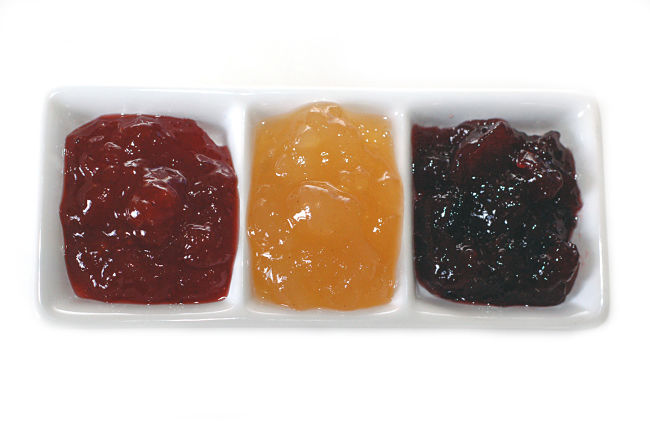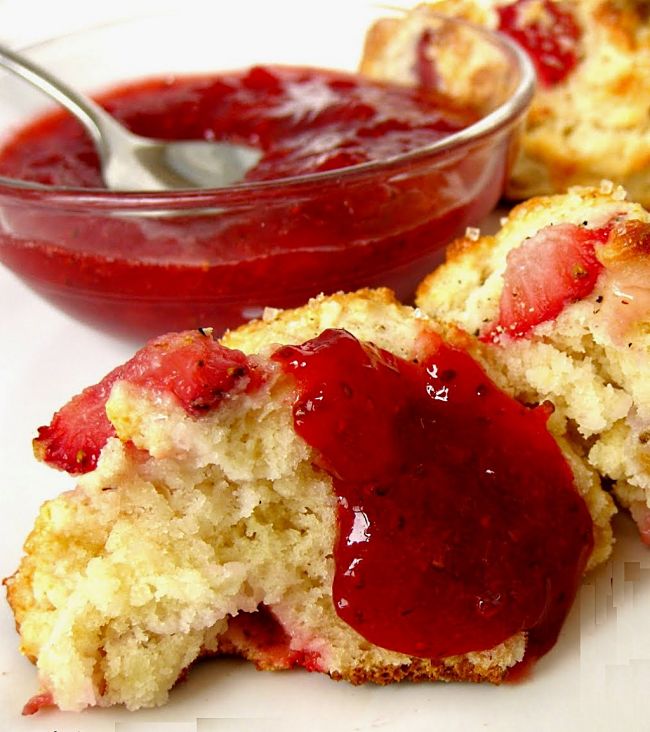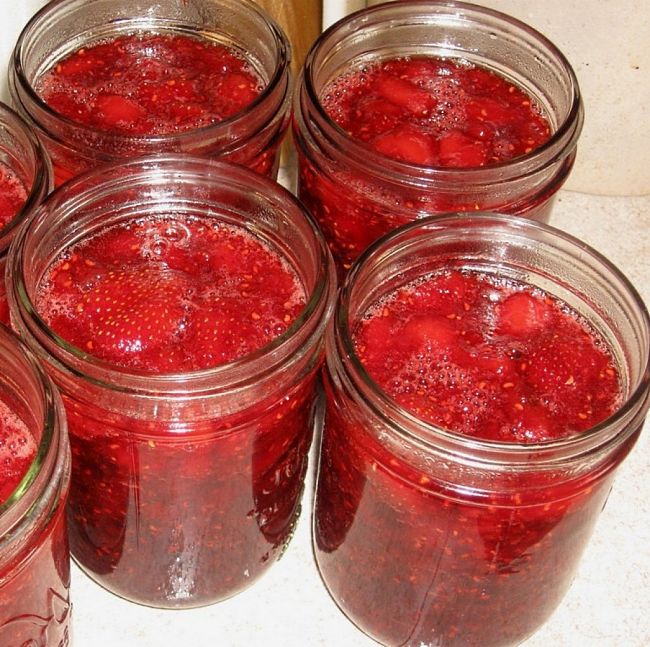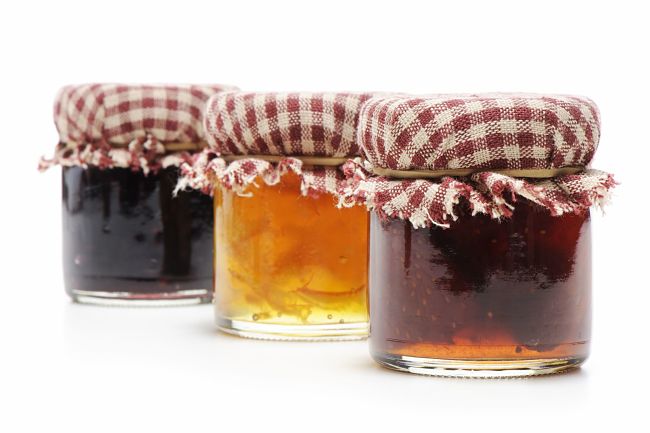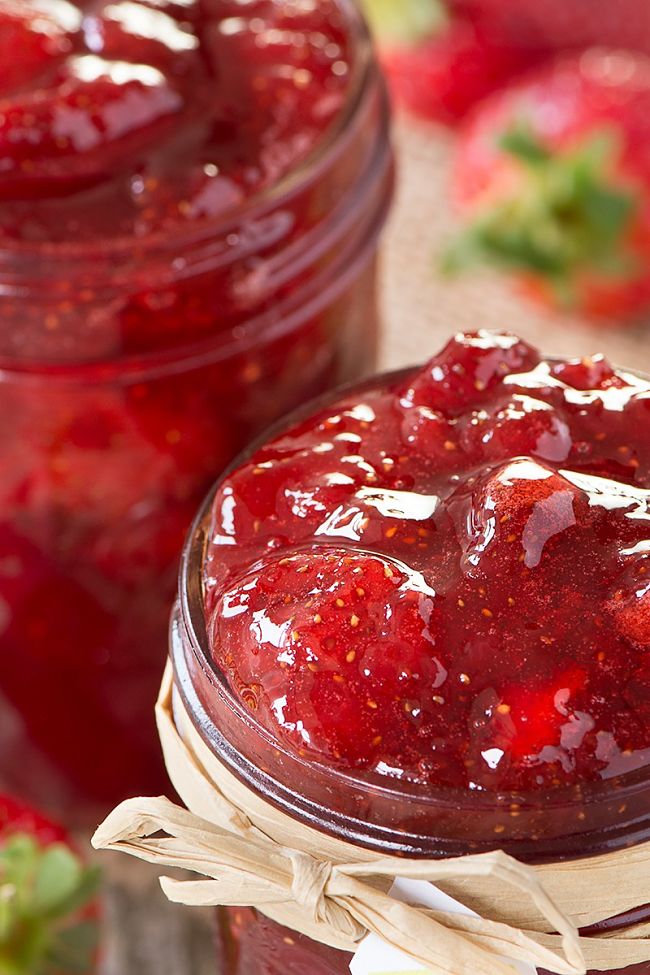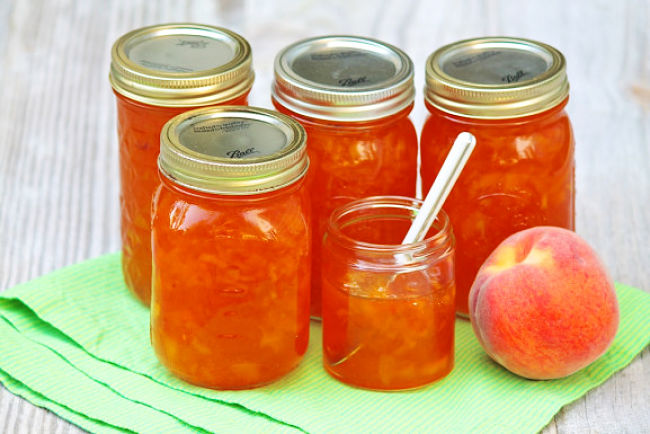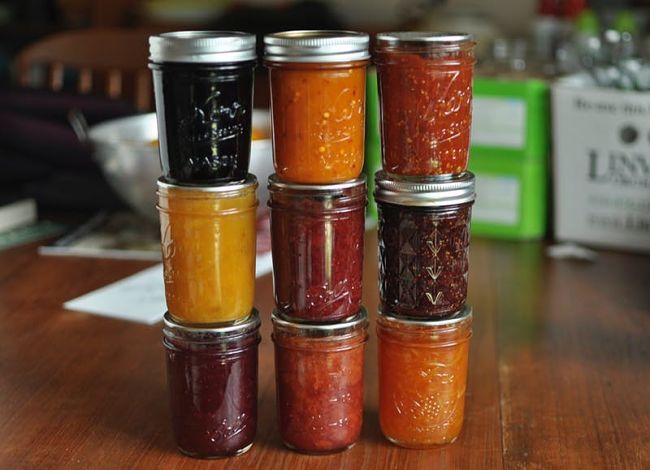Jam not Setting - How to Get All Jam to Set
It happens over and over again. You decide to make some jam. You peel the fruit, you boil it, stir it, poke and prod it, but it won't set. You follow the recipe with meticulous care and attention to every minute detail and the jam still won't set. Why, Oh Why, does this happen?
What can you do to guarantee that the lovely jam, that you spent hour and hours, making over a hot stove, will set every time?
You may have seen lovely rows of luscious ripe strawberries on sale cheaply in the supermarket. You decide to make some strawberry jam, but it won't set no matter what you try.
What could be wrong? Discover why strawberries are a nightmare for jam makers?
Discover which additives work if you get desperate with that pot of liquid that won't gel.
Don't worry and fret anymore as this article provides all the answers for how to get all jams to set properly every time.
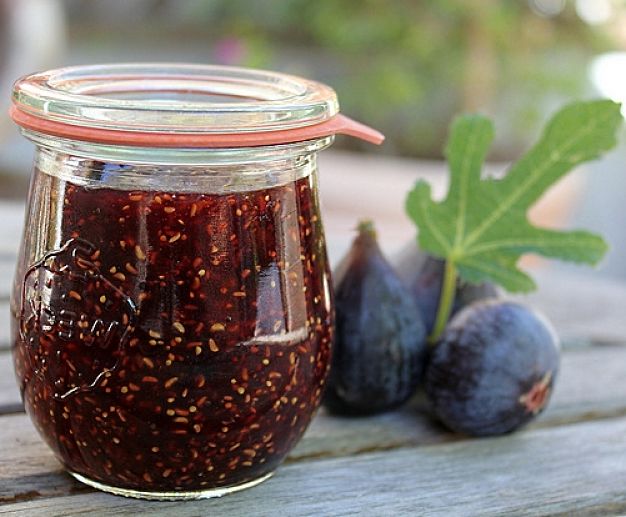
What Makes Jam Set? What can go Wrong?
The answer is pectin, which is a naturally occurring sugar-like substance (a polyscaccaride) found in berries, apples and most other fruit.
When heated with sugar, provided the acidity is correct pectin causes the liquid to thicken in a similar way to how gelatin makes a jelly set.
So what is needed for the pectin reaction to occur and for the fruit liquid to become a gel?
What can go wrong?
- Many fruits contain too little pectin. You guessed it - Strawberries
- Many fruits contain insufficient pectin and so are very prone to slight changes in acidity or sugar levels affecting the gelling process.
- The amount of pectin in fruit declines as the fruit ripens
- The correct amount of acidity is crucial for the to gel process to work. If the liquid is too acidic the gel will never set. If it is too acidic, the gel will lose liquid (weep) and become clumpy and watery. For fruits naturally low in acidity, or unripe fruit, the trick is to add lemon juice or some other fruit as a 'helper'. Kiwi fruit is ideal as it is acidity and rich in pectin.
- The amount of sugar is also critical. Sugar also acts as a preserving agent and contributes flavor. Many people make the mistake of omitting the sugar from the recipe for health reasons. But this does not work as the jam won't set and it is likely to be more prone to bacterial and other infections ruining the jam.
The bottom line is that many jams will need added pectin to set.
This especially applies to strawberries which have little or no pectin, particularly when ripe.
To get strawberry jam to set you will need to add pectin and perhaps lemon juice.
Or you can add some kiwi fruit.
Amount of Pectin Naturally Occurring in Fruit
The table below provides a lists of three groups of fruits with different amount of pectin. The solution is to add extra pectin for fruits that are deficient.
- Fruit which has adequate pectin to gel
- Fruit which is marginal and may require pectin if the fruit is ripe
- Fruit that will always require pectin.
Fruits that Do and Don't Require Pectin and Acid for Jams to Set
|
Always requires added Acid or Pectin, or both
|
Low in Pectin or Acid, need to add either or both
|
Unripe fruit has sufficient natural Pectin and Acid (add some sugar)
|
|---|---|---|
|
Apricots
|
Apples, ripe
|
Apples, sour
|
|
Blueberries
|
Blackberries, ripe
|
Blackberries, sour
|
|
Cherries, sweet
|
Cherries, sour
|
Crabapples
|
|
Figs
|
Chokecherries
|
Cranberries
|
|
Grapes (Western Concord)
|
Elderberries
|
Currants
|
|
Guavas
|
Grapefruit
|
Gooseberries
|
|
Nectarines
|
Grape Juice, bottled
|
Grapes (Eastern Concord)
|
|
Peaches
|
Grapes (California)
|
Lemons
|
|
Pears
|
Loquats
|
Loganberries
|
|
Plums (Italian)
|
Oranges
|
Plums (not Italian)
|
|
Pomegranates
|
Quinces
|
|
|
Strawberries
|
Raspberries
|
|
|
Citrus with skins ( grapefruit, lemons, oranges, tangerines, limes, etc. - the pectin is high in the skin but low in the fruit)
|
Making Jams with Reduced Sugar or Sugar Substitutes
Generally the safest way is to add pectin or gelatine to ensure the jam will set. Always follow a recipe that is designed for a low-cal jam.
Making Jam with No Added Pectin
Wash all fruit and rinse thoroughly before cooking, but do not soak the fruit. For best flavor, use half-ripe fruit, not unripe and starchy, but not fully ripe and soft. Very ripe fruit has less pectin and acid. Remove the skins (optional for some fruits) stems, and pits from fruit, then cut into pieces and crush. Measure the amount specified below or in the recipe using the crushed fruit, not the fresh fruit. Place it into a large saucepan and add the ingredients shown below (of follow a recipe). Add the sugar and quickly bring the fruit to a boil while stirring strongly and continuously. Keep boiling until mixture starts to thicken.
Testing When Jams Will Set When Cooled.
Temperature test: Use a standard candy thermometer and heat until mixture gets to temperature specified for your altitude:
- Sea Level 220 degrees F (104 degrees C)
- 3,000ft 216 degrees F (102 degrees C);
- 8,000ft 205 degrees F (96 degrees C)
Refrigerator test: Take a tablespoon of jam, put it onto a small plat that has been chilled in the freezer. Out it back into the freezer for a few minutes. If the sample gels, the jam is ready to bottle.
Remember that jam may take several days to gel properly in the bottles.
Making Jams and Jellies with Added Pectin
Jam made from fresh fruits, frozen fruit or canned fruit of all types can guaranteed to set by adding powdered or liquid pectins. The two types of pectins require different methods. Jams made with added pectin have larger yields and require less cooking and time for the liquid to reduce. Such jams have more natural fruit flavours for these reasons. Generally follow the recipes below as a guide, and follow the amounts of pectin specified on the pectin packages. Adding about 1/2 teaspoon of margarine or butter helps reduce foaming. However, these may cause off-flavor in a long-term storage of jellies and jams. Fruits for which added pectin works are spiced tomato, strawberry, rhubarb, plum, pear, peach, orange marmalade, grape, gooseberry, fig, currant, cherry, blueberry, youngberry, red raspberry, loganberry, dewberry, boysenberry, blackberry and apricot.
Sample Recipes - Note: Always follow a recipe designed specifically for each type of fruit
Blackberry Jam made with liquid pectin
- 4 cups crushed blackberries
- 1 pouch liquid pectin
- 7 cups sugar
Measure crushed blackberries into a pot. Add the mixture sugar and combine well. Uisng high heat and stirring continuously bring the mixture to the boil quickly and boil vigorously for 1-3 minutes. Remove from the head and stir in the pectin. Skim to remove any skum taht has formed. Pour the jot liquid immediately into hot, sterile jars, leaving a small amount of headspace and seal/
Blackberry Jam made with powdered pectin
- 4 cups crushed blackberries (about 3 quart boxes berries)
- 1 package powdered pectin
- 8 1/2 cups sugar
Follow the same procedure as above
Apricot Jam without added pectin
- 8 cups crushed, peeled apricots
- 1/2 cup lemon juice
- 6 cups sugar
Plum Jam made without added pectin
- 8 cups chopped tart plums (about 4 pounds)
- 6 cups sugar
- 1 1/2 cup water
- 1/4 cup lemon juice
Plum Jam made with liquid pectin
- 4 1/2 cups crushed plums
- 7 1/2 cups sugar
Guide to Jam Making Problems and Their Remedies
The table below summarizes the various problems that often occur when making jam and some suggested remedies
|
Problem
|
Cause
|
Remedy of Prevention
|
|---|---|---|
|
Formation of crystals
|
Excess sugar.
|
Use a tested recipe and measure ingredients precisely
|
|
Formation of crystals
|
Undissolved sugar sticking to sides of saucepot.
|
Dissolve all sugar as jelly cooks. If necessary, wipe side of pan free of crystals with damp cloth before filling jars.
|
|
Formation of crystals
|
Mixture cooked too slowly or too long.
|
Cook at a rapid boil. Remove from heat immediately when jellying point is reached. Make small batches at a time; do not double tested recipes.
|
|
Bubbles in Jam
|
Air becomes trapped in hot jelly
|
Remove foam from jam beforetransferring jars. Prevent jam from gelling until the jars are full
|
|
Bubbles in Jam
|
May be signs of spoilage. Discard
|
Check sterilization procedures
|
|
Jam too soft
|
Overcooking fruit to extract juice
|
Avoid overcooking as this lowers the capacity of pectin to gel the jam
|
|
Jam too soft
|
Using too much water
|
Use only the amount of water suggested, start will less and add as needed.
|
|
Jam too soft
|
Incorrect proportions of juice and sugar
|
Follow the recipe. Don't halve the sugar as it will interfere with the setting
|
|
Jam too soft
|
Undercooking so the sugar is not concentrated
|
Cook the fruit quickly to jellying point.
|
|
Jam too soft
|
Insufficient acid.
|
Add some lemon juice as ripe fruit has too little acid
|
|
Jam too soft
|
Being Impatient, and not waiting long enough for the jam to set
|
8. Some fruits take up to 2 weeks to set up completely; plum jelly and jellies or jams made from bottled juices may take the longer time.
|
|
Jam too watery
|
Too much acid in the juice makes pectin unstable
|
Maintain proper acidity of juice, add sugar
|
|
Jam too watery
|
Storage are too warm
|
Store processed jars in a cool place. Refrigerate before using
|
|
Jam too Dark
|
Overcooking sugar and juice.
|
Avoid long boiling. Best to make small quantity of jam and cook rapidly.
|
|
Jam too Dark
|
2. Stored too for long or at a high of temperature
|
Store processed jars in a cool place and use within one year
|
|
Cloudiness or milkiness in the Jam
|
Green fruit (has starch that causes cloudiness
|
Use firm, ripe fruit - slightly underripe.
|
|
Cloudiness or milkiness in the Jam
|
Jam allowed to stand before pouring into jars or pouring too slowly
|
3. Pour into jars immediately upon reaching gelling point. Work quickly.
|
|
Mold or Fermentation (Denotes spoilage; do not use.)
|
Yeasts and mold grow on jam
|
Pre-sterilize jars by immersing for 10 minutes in boiling water
|
|
Mold or Fermentation (Denotes spoilage; do not use.)
|
Imperfect sealing and storage in warm areas
|
Use proper lides that seal proerly and can be sterilised. Store in cool place.
|
|
Too stiff or clumpy
|
Overcooking
|
Follow insructions
|
|
Too stiff or clumpy
|
Too much pectin in fruit or added
|
Use riper fruit. Decrease amount of pectin added
|
|
Too stiff or clumpy
|
Too little sugar which requires excessive cooking and loss of moisture
|
When pectin is not added, add 3/4 cup of sugar for each 1 cup of juice for most fruits
|
More Great Tips for Getting Jam to Set Every Time
Understand pectin
Pectin is the fiber that stiffens the cell walls of fruits and vegetables. It exists in all fruits and vegetables but some types have more of it than others. High pectin fruits like blueberries, apples, and cranberries don’t need any additional pectin and can be used in combination with other fruits to boost the amount of pectin in the mixture when making jam. If you’re working with low pectin fruit like strawberries or pears, there’s no shame in using some commercial pectin, as it will give the sugar more fiber with which to bond.
Watch the way the jam drips
Swirl your spatula through your cooking jam, hold it up over the pot, and watch how it falls. If the jam runs right off the spoon and looks thin and runny, it’s not done yet. However, if it forms thick droplets that hang heavily off the bowl of the utensil, but don’t immediately fall off, it is either nearing completion or is done.
Use a candy thermometer
When you’re making jam with traditional amounts of sugar, you’re aiming to cook it to 220 degrees F 104 degrees C. That’s the temperature at which sugar forms a gel and can combine with the pectin (whether it naturally occurring in the fruit or you’ve added it). Monitoring the temperature can give you confirmation that you’re on the right track.
Use the freezer test
At the beginning of cooking, put two or three small plates or bowls in the freezer. As you begin to approach the end of cooking, pull one out and put a small dollop of jam into the middle of the dish. Tuck it back into the freezer for two or three minutes (take your jam off the heat during this time, because if it the test tells you it’s done, you will have just spent three minutes overcooking your jam). When the time is up, pull the dish out of the freezer and gently nudge the dollop of jam with the tip of your finger. If it has formed a skin on top that wrinkles a bit when pushed, it is done. If it is still quite liquid and your finger runs right through it, it’s not done yet.
Use a low or no sugar pectin
One of the reasons that people often wind up with runny jam is that they couldn’t bear to use the amount of sugar necessary to get a conventionally sweetened batch to set. If you’re trying to lower your sugar consumption but still want jam, try Pomona’s Pectin. It allows you to make a spreadable jam that’s sweetened with a small amount of sugar, honey, Stevia or other alternative sweetener.
Give it time
Jam can take up to a week to achieve its finished set. Don’t declare it a failure ten minutes out of the canner. Patience pays.
